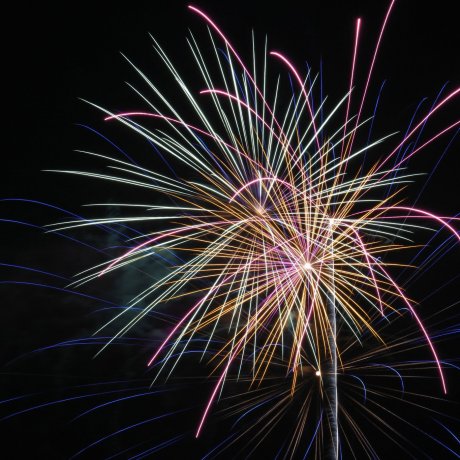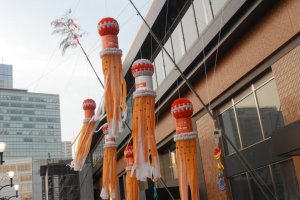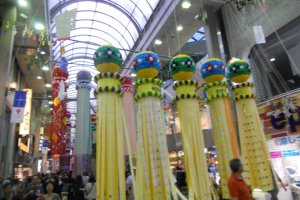One of the best times to be in Sendai is during the Tanabata Festival from August 5th through 8th. A well known star festival, the event celebrates the meeting of the stars Vega (Orihime) and Altair (Hikoboshi). While there are plenty of places you can catch the festival, Sendai is home to one of the biggest in all of Japan. In fact, it is one of the three major festivals in the Tohoku region ranking alongside the Nebuta Festival in Aomori, and the Kanto Festival in Akita.

The best route I could recommend to experience as much of the festival as possible would be to start from Sendai Station and walk down Clis Street, a major outdoor shopping district that runs downtown. The city will be jam packed with visitors, many of whom will be roaming the streets in summer yukata so be prepared for traffic.
Along the way you will see many of the breathtaking decorations made by citizens from all over Japan, from Kushidama to paper cranes and kimono, to characters representing legendary samurai Masamune Date.

Some of the most heartbreaking of decorations come from Nagasaki and Hiroshima, where thousands of cranes have been woven together to represent the lives lost in the atomic bomb blasts. My first Tanabata trip was just months after the 2011 earthquake, so there were plenty of similar decorations to mourn the lost lives from the devastated areas. I highly recommend bringing a camera and taking as many pictures of possible of these wonderful works of art.
If you continue on, you will reach Jozen-ji-dori in the Kotodai Koen area. Near city hall, and in other places down the street, you will find racks of bamboo have been set up. Here you can write a wish (or if you want to be more traditional a poem) on slips of paper called tanzaku and hang them on the bamboo.

The next day or in some cases on the last day of the festival, the slips are either burned or set adrift down a river. Your wish doesn’t have to be in Japanese so it is a great way to get into the spirit overtaking the city. After you finish there, I recommend hanging around the squares and parks all along Jozen-ji-dori. Concerts and live traditional dances will be going on all along this road and food stands will be set up all over the place giving you a chance to grab some tasty festival grub and beer if you are hungry.

For those interested, Nishi Koen Park is the place to be if you want to catch the August 5th fireworks show. It is a 10-minute walk from Kotodai Koen Subway Station (just follow the street signs). I recommend arriving at least an hour before the 7pm start time in order to secure a nice picnic spot as space becomes difficult to find very quickly. For those worrying about food, vendors will be set up selling everything from takoyaki to yakisoba and much more.

Sendai Tanabata Fireworks Festival 2026
16,000 fireworks light up the sky over the Hirose River every August 5th evening. This is the kickoff for 3 days of Tanabata F..
It is very easy to see why Sendai has one of the best summer festivals in Tohoku. Anybody who wants to have a wonderful experience experiencing traditional Japanese culture, or anyone who wants to enjoy the city at its best should seriously consider a visit during Japan’s summer festival season.
The myth behind Tanabata

The festival celebrates the meeting of Orihime (weaving princess in Japanese) and Hikoboshi (cow herding star), or Vega and Altair respectively.
According to the story, Orihime was a princess who weaved fine clothes for her father Tentei (the sky king) on the bank of the Amanogawa (the Milky Way). While her skill impresses her father, the princess longs to find love, so Tentei arranges for Orihime to meet Hikoboshi, a cow farmer from the other side of the river. After falling in love, Orihime stopped making any more clothes, and Hikoboshi let his cows run all over heaven. Furious, Tentei separates the two using the river, but when he sees his daughter become heartbroken, he strikes a bargain with the literal star-crossed lovers; if they do their duties as required, on the 7th day of the 7th month each year, he will allow them to see each other.
And on that day, a group of magpies shall use their wings to make a bridge for Orihime to cross over to see Hikoboshi. However, if it rains on the day of Tanabata festival the magpies will not come, leaving the two saddened lovers to wait until the following year to meet.
The history of Sendai Tanabata Festival

The city of Sendai began to celebrate this festival during the Edo period (1603-1867) after its founding by samurai warlord Masamune Date.
The festival grew bigger and more popular over the years, but fell into decline during several transition periods in Japanese history including the Meiji Restoration and both World Wars. It was in 1928 in the wake of the economic depression that gripped Japan after WW1 that citizens began to celebrate the festival from August 6th through the 8th - a month later than the 'official' date. It was only later on when the festival began to be celebrated on the 5th rather than the 6th that a fireworks show was included to kick off the celebrations.
The decorations of the Tanabata Festival

The most noticeable decoration you will find is the kushidama, which are large paper balls with long streamers. They were originally modeled after the dahila flower, but in recent years other forms such as boxes and paper characters have become more popular.

The streamers on a kushidama represent the strings Orihime uses to weave clothes for her father. You will also see other items hanging from these decorations, each of which represents a different blessing.
Paper strips with handwriting represent good luck in studies. The paper kimono wards off accidents and ill health. The paper crane represents family safety, health and longevity. A purse represents good business. A net represents good fishing and harvests. The trash bag represents thriftiness and cleanliness. As I noted before, all of these decorations were made and donated from all across Japan.
Tanzuku

Tanzuku are pieces of paper upon which wishes can be written. They can be written in Japanese or any other language informally, or in the more traditional poetic form.
After you finish, the wish is tied to a rack on a bamboo wish tree. They are usually burned on the final day of Tanabata or sent downstream, similar to scenes seen during the Japanese Obon Festival.

































